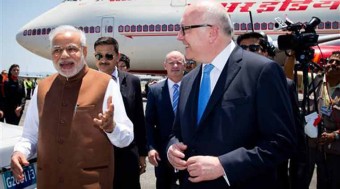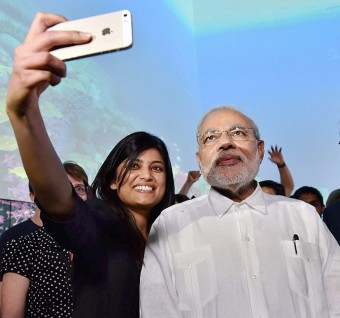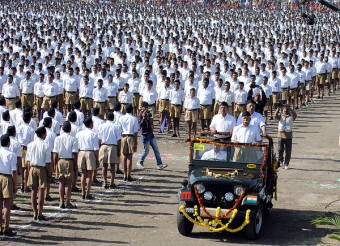
What’s not to love about an Indian Prime Minister who tweets? And who plans to address the Australian Parliament in one of India’s official languages, Hindi? Who joins Instagram just two days before touchdown in Australia? There is so much to love about the first Indian Prime Minister to come to Australia in 28 years.
This is why a community reception will be held this evening in no less a community center than the Allphones Arena in Sydney. With a seating capacity of 21,000, it is easily Australia’s largest indoor venue, built for the Sydney Olympics in 2000.Some would say that Allphones Arena is an apt name for a venue that will host a Prime Minister who takes selfies, but that’s besides the point.

The Australian, Indian, and Indian-Australian media have gone all out to support this visit and create a feeling of pride as the leader of our homeland comes calling.
There are many trails of breadcrumbs between India and Australia, on geological and symbolic paths that lead us to and from home.
From Gondwanaland, when Australia and India were part of one super continent millions of years ago, to the trade on the ancient silk roads of the sea between Indigenous Australians and Indians, from the Indian sailors on the First Fleet in 1788, including a sailor named Singh who is said to have ‘discovered’ the strait of water between Melbourne and Van Diemen’s Land (Tasmania), to the thousands of Indian students who prop up Australia’s education industry with borrowed capital today, Australia has always been charged with India.
Officially there are around 450,000 people of Indian origin living in Australia.
As Indian Australians, many of us confront our entangled affinities daily, much like other diasporic communities, as we try to understand our place in Australia while at the same time drawing sustenance through roots in the India we left behind.
As Indian Australians we have often been praised for our model minority behavior (unlikely to upset the political status quo), our medical skills, and our food. As Indian Australians we have often been ridiculed for our accents, our body odour, and, yes, again, our food.
The 2010 spate of violence against Indian students thrust the Indian Australian diaspora into the glare of the media. For many it highlighted the paradox, the sense of belonging here to this country we have made our home, and simultaneously, not really being seen as nor seeing ourselves as ‘Australian’.

It is into this environment of ancient amnesia, anxieties of fitting in, and coming to terms with our increasing public visibility, that Indian Australians welcome the Indian Prime Minister to Australia for the first time in 28 years.
In a geopolitical climate where India’s stars seem to be auspiciously aligned, with a uranium deal done and dusted, with the great metaphorical vitality of once-colonised India as future superpower and intellectual powerhouse, the leader of our homeland coming to our adopted country is meant to fill us with love, and hope and postcolonial pride.
And yet and yet, this is not just any prime minister, this is Narendra Modi. The man who came to power this year with a 31% majority for his party, the Bharatiya Janata Party (BJP), without the family backing enjoyed by the Congress Party’s Nehru-Gandhi dynasty.
However, while not part of a dynasty he was backed by another kind of family, the Sangh Parivar. According to its official website, the BJP is the most prominent member of the Sangh Parivar, which is a “collection of Hindu Nationalist organisations” including the Rashtriya Swayamsevak Sangh (RSS), one of whose members assassinated Mahatma Gandhi, with “well documented links to European Fascism”.
Modi is largely famous for the industrialisaiton and development in Gujarat state under his tenure as Chief Minister from 2001-2014. Several of the reasons Modi is exceptional have been on showcase during his trip down-under. Looking at scientific research, when asked to write a message on an agricultural robot at the Queensland University of Technology, Modi wrote in Hindi, “Research is the mother of development”.

Yet Modi has written prefaces to children’s textbooks currently being studied by tens of thousands of students in Gujarat, claiming that the flying chariots of the ancient Hindu epic, the Ramayana, prove that jet planes were invented in India in our ancient past.
He comes here having given a speech in October this year, at the inauguration of the new Reliance hospital in Mumbai echoing the Gujarati textbooks, as reported on his own official website, and translated here:
“We worship Lord Ganesh. There must have been some plastic surgeon at that time who got an elephant’s head on the body of a human being and began the practice of plastic surgery.”
Upon hearing this speech and reading the textbooks on Gujarat’s new compulsory reading list, people such as author Mukul Kesavan and author-diplomat Pavan K. Varma have expressed concern that imaginative mythology is being treated as scientific fact.
The “facts” in these textbooks border on Rushdie-esque magic realism, and are written by none other than Dina Nath Batra, the same man responsible for the pulping of the scholar Wendy Doniger’s book On Hinduism. You can almost picture him blowing on his boxing gloves after he was allowed to punch the living daylights out of Freedom of Speech in India.
Yet discussion of this and other contradictions has been largely muted in Australia.
———–
(Part two on Hindutva in Australia, growth and the G20 coming soon)


1 thought on “Modi in Oz: Diaspora, Tweets and a PM of Science? (Part one)”
Comments are closed.